Matador Network's Blog, page 232
November 29, 2023
The World’s Driest Desert Is Also An Incredible Place For Stargazing

The Atacama Desert, the driest place on Earth, is a high-altitude plateau that once lay at the bottom of the ocean. If the elevation doesn’t leave you feeling woozy then the Martian landscapes, geysers, volcanoes, and altiplano lakes will soon put you right. Another reason to visit this parched spot in northern Chile is for astrotourism.
Sitting at 8,015 feet, the dusty oasis of San Pedro de Atacama is the gateway to the desert landmarks and the clearest skies in the world. The region is so remarkable that NASA tests equipment for lunar missions in this part of the Chilean desert.
Eight hundred miles south of San Pedro, greener, and at a more breathable altitude, the Elqui Valley is an alternative option for star trekkers in Chile. Named after the Nobel-winning poet Gabriela Mistral, who grew up in Vicuña, this wine region pipped San Pedro to the post when it became the world’s first designated International Dark Sky Sanctuary in 2015.
Astrotourism in the Atacama Desert
Photo: Tatsuya Ohinata /Shutterstock
As the most arid non-polar desert, the Atacama receives minimal rainfall and virtually no cloud cover. There is zero light pollution, next to no radio interference, and thinner air allows for greater precision. In fact, the largest radio telescope on the planet, the Atacama Large Millimeter/submillimeter Array (ALMA), is located in the Chajnantor plateau. Watch this space for the reprisal of free public tours to the base camp.
Astronomical tours in San Pedro de AtacamaEvery tour agency on San Pedro’s primary tourist corridor, Caracoles Street, sells astronomical tours. These nocturnal activities are led by a professional astronomer at private locations on the town outskirts. Every tour is different as the night sky is impossible to predict but you’re guaranteed an eyeful of stars, planets, nebulae, and other celestial objects plus hands-on experience with the telescope.
They’re pitched at astronomers of all levels but the narration gets pretty technical so you’ll want to double-check that your tour is in English. While you wait your turn for the Azimuth Mount telescope, keep watch for shooting stars.
Astronomical tours typically cost 30,000 CLP ($33) per person. This price should include transport to and from your hotel in San Pedro, an astronomical talk, and stargazing through professional telescopes. The best tours are capped at 12 participants. Turismo Gato Andino and Layanna Travel are two of the most reputable agencies on Caracoles. Llama Stargazing runs tours in English that are bookable on Airbnb Experiences.
We hope you love these astrotourism experiences! Just so you know, Matador may collect a small commission from the links on this page if you decide to book a tour or stay.
Visit the Meteorite Museum
ALMA telescope. Photo: Fluglinse/Shutterstock
Installed in a geodesic dome in San Pedro, the Meteorite Museum is a nice addition to any astrotourism visit in northern Chile. Different types of meteorites are showcased through displays of chondrites, mesosiderites, and pallasites turfed from the Atacama by a local collector, Rodrigo Martinez. The audio guide is rounded off with a mini masterclass on detecting meteorites plus the chance to pocket a fragment from the gift store.
Open Tuesday through Sunday between 6 PM and 9 PM, the museum will warm you up before an astronomical tour.
Gabriela Mistral Dark Sky Sanctuary
Photo: Cavan-Images/Shutterstock
The Gabriela Mistral Dark Sanctuary sits in the lower Atacama Desert in the lush Coquimbo region. Topping out at 6,500 feet, Chile’s northernmost wine region is an alternative stargazing destination for travelers averse to parched climates and dizzying altitudes. As many of the standard tours in San Pedro are off-limits to younger children, pregnant women, and those with certain health conditions, the public observatories in the Elqui Valley are more suitable for travelers who fall under these categories.
Tickets to visit the Observatorio Cerro Mamalluca are sold at the kiosk in Vicuña Plaza. These depart at 6.30 AM in winter and 8.30 PM in summer except the nights directly before and after the full moon. Tours cost 12,000 CLP ($14) plus 5,000 CLP ($5.50) for the transfer.
This astronomical hiking tour with a local astronomer coincides with sunset. Once in the mountains, you’ll watch the constellations light up the valley while the guide shares an indigenous perspective of astronomy.
Independent stargazingIt’s simple enough to venture out for an independent stargazing session although you’ll miss out on telescopes and stellar intel on the night sky. With a rental car, you can drive to the outskirts of San Pedro and pull up in one of the laybys near the Piedra del Coyote viewpoint. If you’re on foot or have a rental bicycle, just following the main roads away from the lively Caracoles will yield starry skies. Available on Apple and Android devices, Stellarium is a free app that helps you locate constellations and visible planets.
Solo star trekking beyond the main roads in San Pedro and the Elqui Valley isn’t recommended as it’s easy to get lost. Cell service is patchy in rural Chile so it’s handy to have an offline app such as Maps.me when driving.
Best time to go stargazing in the Atacama Desert
Photo: Cavan-Images/Shutterstock
Stargazing in the Atacama is impacted by the moon phases and a short, sweet, and surprisingly fierce rainy season. June, July, and August deliver the sharpest conditions for stargazing in the Atacama and the best time for seeing the Milky Way. As this is winter in the Southern Hemisphere, nights are freezing with temperatures plunging into the low 20s.
October and November are superior for clear skies and pleasant temperatures in both San Pedro and the Elqui Valley. This is also when you might catch the Atacama’s desierto florido, a rare desert bloom in Llanos de Challe National Park. San Pedro’s rainy season occurs in late January or mid-February. It will only rain for a couple of days but the downpour will be mighty.
The worst time for seeing the stars is around the full moon. Most providers pause their tours up to five days before or after whereas others switch to an astrolunar tour. It’s still possible to observe celestial happenings but they are fairly diminished. Still, the opportunity to view the craters of the moon through a telescope isn’t a bad experience. Take a tip from someone who learned this the hard way: Don’t gaze at the moon through the telescope for longer than five seconds.
Where to stay for stargazing in AtacamaTierra leads the way for luxury lodging in Chile. The Tierra Atacama Hotel and Spa offers desert-view rooms and a swimming pool overlooking Licancabur Volcano. It’s a 20-minute walk from Caracoles but the hotel has an excellent restaurant on-site and arranges tours from the lobby.
Accommodation is far more affordable in the Elqui Valley. Elqui Domos makes stargazing from bed even easier than streaming with its geodesic domes and observatory-style cabins. 
‘Mountain of Hell’ May Be the Most Extreme Bike Race in the World

For most hobbyists, mountain biking as a sport isn’t nearly as extreme as it looks in videos. Sure, there’s always the potential to fall, but with the proper protective gear, the average mountain biker can usually stay pretty safe, especially if they’re sticking to established cross-country trails.
But the bikers participating in France’s Mountain of Hell bike race are not your average mountain bikers. Since it’s cut-and-dry race — the first person to the bottom wins — they go very, very fast. Last year’s winner, French professional mountain biker Kilian Braun, clocked speeds of up to 62 miles per hour.
Here’s what it looks like to be in the race.
@bikegm The biggest mountain bike – Part 2 #bike #mounntain ♬ original sound – bulmetxp672
Mountain of Hell is an extreme downhill mountain bike race held annually in the French Alps, on a glacier ski resort called Les Deux Alpes. The course is just over 15 miles long and looses about 7.600 feet of elevation from start to finish.
The Mountain of Hell course has a few other challenges, too: the top section is almost always covered in snow (but riders aren’t on fatbikes), there are huge downhill sections of loose rocks and boulders, and you’re competing against up to 999 other racers who are usually mere feet from your bike, moving at top speeds. And it can be almost impossible to see through fog and snow at the top.
The first half of the race looks wild and borderline dangerous as riders push to pass each other.
@bikegm The biggest mountain bike – Part 1 #bike #mountain ♬ original sound – bulmetxp672
As you may imagine, bike crashes are a given and can be brutal to watch (though no one was hurt in the instance below, supposedly).
The race has a bigger vertical drop than nearly all of the most famous expert trails in the entire United States, including the Whole Enchilada in Moab, Utah (7,000-foot loss) and Downieville, in the Sierra Nevada of northern California (5,000-foot loss). And the “Mountain of Hell” course is way steeper and full of risks, as riders will often pass each other on singletrack trails barely wide enough for one person. The winning time in 2023 was a mere 22 minutes, moving at speeds faster than most cars on the highway.
You can watch the whole race from the point of view of a contestant in the video below, who finished with a still-very-impressive time at under 50 minutes.
Believe it or not, non-pro athletes interested in competing in the absolutely wild race are able to do so. Mountain of Hell will once again be held in France in 2024, from June 21-23. Registration is 95 Euro, or about $105, per rider. The exact date registration opens will be posted on the event’s official Facebook page; registration includes a breakfast hosted by the sponsor (Commencal, in 2023) and your lift ride to the start of the course. It’s open to any enduro or downhill adrenaline junkies, but unless you’re the kind of rider who can send it down A-line in Whistler or has shot a few mountain bike movie camos, you’ll probably find that spectating is the way to go.
Les 2 Alpes is a ski resort in the town of Vénosc, in southern France. The closest airport is Grenoble Isère airport, which isn’t very large. But fortunately, the town is only about 45 miles from the Grenoble train station, making it easy to reach from other destinations like Geneva, Switzerland (two hours) or Lyon, France (90 minutes). Paris is also only about threew hours by train.
From the Grenoble station, you can grab a ride share to Les 2 Alpes, or take the affordable area shuttle bus, which runs between the train station and several stops in the towns closest to the resort. 
Take in Alhambra Views From These Airbnbs in Granada, Spain

Located in the foothills of the Sierra Nevada mountains, Granada is presided over by the Alhambra and those snow-capped ranges. Despite the stronghold summoning travelers by the droves, the Andalusian city slips under the radar and offers a rich cultural experience minus the crowds of Spain’s largest cities.
Staying in Granada Centro or the Jewish quarter of Realej puts you within walking distance of the principal sights. The Moorish settlement of Albaicín (Albayzín) is the oldest part of town with spine-tingling vistas that justify the hilly terrain. This bohemian neighborhood trickles into Sacromonte, the cradle of flamenco art, where Spanish Gypsies carved homes right into the hillside. Grenada Airbnbs give you a choice of staying in one of these ancient cave houses, traditional Andalusian carmenes, and lofts in eyeshot of the Alhambra.
Traveling to Spain? Check out Matador’s Spain accommodations guides: 14 of the best Airbnbs in Barcelona 11 Best Airbnbs in Madrid, From a Luxury Penthouse To Artsy Apartments Discover the Best of Granada With These Airbnb Experiences Experience the best of Mallorca from these Airbnbs The most stunning Airbnbs in Tenerife for an epic getaway
We hope you love these Airbnb Granada vacation rentals! Just so you know, Matador may collect a small commission from the links on this page if you decide to book a stay. Listed prices are accurate as of the time of publication.
Beautiful family home on Granada’s prettiest street Photo: Airbnb
Photo: Airbnb Photo: Airbnb
Photo: Airbnb Photo: Airbnb
Photo: Airbnb Photo: Airbnb
Photo: AirbnbSee more photosStay in the quaintest vacation rentals straight off the photogenic Carrera del Darro. Comfortably lodging eight guests, the top-floor apartment is perfect for families with children. It’s more modern than other properties in town yet retains the original character of the UNESCO World Heritage neighborhood. Spend breakfasts and evenings congregating on the terrace with unobstructed views of Spain’s landmark fortress.
Eight guests, three bedrooms
Price: $182 per night
 Photo: Airbnb
Photo: Airbnb Photo: Airbnb
Photo: Airbnb Photo: Airbnb
Photo: Airbnb Photo: Airbnb
Photo: AirbnbSee more photosWake up to sunrise over the Alhambra and Generalife gardens at this Airbnb in Granada’s Albaicín. The sun trap of a terrace is furnished for afternoon tea breaks and chatty siestas while the interiors stay cool in summer thanks to the gushing water fountain and terracotta tiling. The palatial experience is topped off with a lavish bathing suite clad with Nasrid ceramics and a sunken hot tub.
Twelve guests, three bedrooms
Price: $263 per night
 Photo: Airbnb
Photo: Airbnb Photo: Airbnb
Photo: Airbnb Photo: Airbnb
Photo: Airbnb Photo: Airbnb
Photo: AirbnbSee more photosA brand new listing from an established Superhost, this luxurious Airbnb is convenient for Grenada Centro and Realejo. The design marries traditional Spanish elements with premium appliances, a squashy couch, and silky soft linens. As the apartment straddles two floors and one bedroom has a kitchenette, it’s ideal for a pair of couples or vacationing friends who value privacy. The Jacuzzi completes an epic stay in Andalusia.
Six guests, two bedrooms
Price: $256 per night
 Photo: Airbnb
Photo: Airbnb Photo: Airbnb
Photo: Airbnb Photo: Airbnb
Photo: Airbnb Photo: Airbnb
Photo: AirbnbSee more photosAn alternative cave Airbnb in Grenada, this stylish rental sits on the outskirts of town on the main road to Sierra Nevada. Alpujarra textiles and Andalusian ceramics add comfort and warmth to the interiors while the outdoor space is a massive perk. As the pool and yard are shared with only one other unit, the property remains exclusive and serene. Parking is available otherwise it’s a two-minute walk to the nearest bus stop.
Four guests, two bedrooms
Price: $175 per night
 Photo: Airbnb
Photo: Airbnb Photo: Airbnb
Photo: Airbnb Photo: Airbnb
Photo: Airbnb Photo: Airbnb
Photo: AirbnbSee more photosThis open-concept studio near Sacromonte is a marvelous base in Andalusia for a honeymoon hideaway – or for solo wanderers who travel in style. The bed was handcrafted by the homeowner who also repurposed an old sewing table as a work desk. At first glance, the kitchen looks rudimentary but you’ll find all you need to prepare a terrace feast. That oversized soaking tub is the icing on the cake after a day in the valleys.
Two guests, one bedroom (studio)
Price: $99 per night
 Photo: Airbnb
Photo: Airbnb Photo: Airbnb
Photo: Airbnb Photo: Airbnb
Photo: Airbnb Photo: Airbnb
Photo: AirbnbSee more photosOne of the best Airbnbs in Granada for a couple, this chic one-bedroom apartment is modeled on a boutique hotel. The private patio overlooks the snowy massif and has a dipping pool that saves the day on a sweltering summer afternoon. Pop upstairs to the roof deck where you can swim in the communal pool. Super central, Plaza de la Trinidad is handy for the train station, cathedral, and endless tapas bars.
Two guests, one bedroom
Price: $152 per night
 Photo: Airbnb
Photo: Airbnb Photo: Airbnb
Photo: Airbnb Photo: Airbnb
Photo: Airbnb Photo: Airbnb
Photo: AirbnbSee more photosRetreat to the Albaicín hills and stay at this two-villa complex for large groups. The main residence and guest suite are linked by a landscaped garden peppered with sculptures and fruit trees plus a gigantic swimming pool. The carmen’s interiors are a homage to yesteryear with hefty wooden beds, rustic picture tiles, and baubles galore – although the sauna adds a modern touch. Toss a euro in the wishing well to guarantee a return to Granada!
Twelve guests, six bedrooms
Price: $524 per night
 Photo: Airbnb
Photo: Airbnb Photo: Airbnb
Photo: Airbnb Photo: Airbnb
Photo: Airbnb Photo: Airbnb
Photo: AirbnbSee more photosTwo hundred (and counting) five-star ratings speak for themselves. This top-rated Centro Airbnb is steps from Granada Cathedral and a 15-minute stroll from the Nasrid Palaces. On a practical note, you have a spotless kitchen, personalized tips from the host, lightning-fast Wi-Fi, and – that rare luxury in Europe – an elevator. Sliding doors blur the lines between indoor and outdoor living while the sunsets are out of this world.
Three guests, one bedroom
Price: $170 per night
 Photo: Airbnb
Photo: Airbnb Photo: Airbnb
Photo: Airbnb Photo: Airbnb
Photo: Airbnb Photo: Airbnb
Photo: AirbnbSee more photosThe unique rental includes the cave-dwelling plus a modern extension. Grotto rooms feature whitewashed concave walls, deep-set bathtubs, and monumental arches whereas the kitchen is drenched in sunlight. Step out to the terrace and you’ll score panoramic views of Downtown Granada and the Sierra Nevadas. It’s fairly out of the way but the host can connect you with an English-speaking taxi driver for stress-free access.
Eight guests, four bedrooms
Price: $145 per night
 Photo: Airbnb
Photo: Airbnb Photo: Airbnb
Photo: Airbnb Photo: Airbnb
Photo: Airbnb Photo: Airbnb
Photo: AirbnbSee more photosThis historic Granada apartment is stationed inside a 16th-century residence in Plaza de las Pasiegas. A “suspended” passage connects the den to the second floor where you’ll find a flashy kitchen and bathroom. Nimble travelers can scramble up the ladder and bed down in the mezzanine that peeps over the cathedral. It’s as central as you’ll find which means evenings come with an ambient soundtrack of buskers and chatter.
Six guests, two bedrooms
Price: $134 per night
In keeping with the rest of mainland Spain, Andalusia follows Central European Time (CET). Central European Summer Time (CEST) is observed during summer. This puts the standard time in Granada at UTC/GMT +01:00 and the current time at UTC/GMT +02:00.
What is there to do in Granada?It would be simple enough to spend a week draped on the balcony of your Granada Airbnb drinking up the skyline. However, that would mean missing out on these sights and experiences unique to the Andalusian city.
Tour the Alhambra of Granada and hear how the Nasrid Kingdom influenced the Iberian Peninsula. Fusing Moorish and Andalusian architecture, the stronghold and Nasrid Palaces are best explored with a local guide before exploring the Generalife Gardens solo.Connect with flamenco culture in the neighborhood of Sacromonte where nightly performances are held in caves built by Spanish Gypsies.Climb up to the San Nicolás Viewpoint (Mirador de San Nicolás) for a 360-degree perspective.Press pause on history and brush up on tech and conservation at Granada Science Park (Parque de las Ciencias). The motto is, it’s “forbidden not to touch”.Dodge the heat at Granada Cathedral and see the Royal Chapel (Capilla Real de Granada) where Spanish royalty are laid to rest.Explore the ancient El Bañuel Arab bathhouse. Right next door, the modern Al Ándalus bathhouse offers Hamman treatments and cleansing rituals.Visit the immersive exhibition of 11 cave dwellings at the Sacromonte Cave Museum (Museo Cuevas del Sacromonte).Go teashop-hopping on Calle Calderería Nueva where teterías hark back to Andalusia’s Moorish past.Join a food tour or embark on an independent tapas crawl along Calle Nevas or at Mercado de San Agustín.Ski at Europe’s most southerly ski resort in the Sierra Nevada National Park, setting of Mount Mulhacén. The pistes usually open in late November but hiking, biking, and wildlife watching are available between April and the grand opening.
 More like thisCultureWhy Granada Is Our Favorite City in Spain
More like thisCultureWhy Granada Is Our Favorite City in Spain
November 28, 2023
Explore the Artistic and Culinary Elegance of Dallas

Dallas, Texas, beckons visitors with a compelling blend of cultural richness and modern allure. The city’s vibrant cultural scene boasts world-class museums such as the Dallas Museum of Art and the Perot Museum of Nature and Science. History comes alive at Dealey Plaza, forever etched in memory as the site of President John F. Kennedy’s assassination, and the Sixth Floor Museum provides a poignant exploration of that pivotal moment. Dallas also offers an array of sports experiences, from cheering on the Dallas Cowboys to catching a game with the Mavericks or the Texas Rangers. The city’s shopping districts, including NorthPark Center and the Galleria Dallas, cater to diverse tastes, and its culinary landscape ranges from authentic Tex-Mex and barbecue joints to upscale dining in trendy neighborhoods like the Bishop Arts District.
Beyond the urban landscape, Dallas embraces outdoor enthusiasts with parks and recreational areas like White Rock Lake and Klyde Warren Park. The city pulsates with live music, particularly in the vibrant Deep Ellum district, and hosts a myriad of events and festivals throughout the year, including the renowned State Fair of Texas. Architectural marvels such as the Reunion Tower and the Bank of America Plaza define the modern skyline, offering a visual feast for admirers of contemporary design. Yet, amidst its impressive attractions, Dallas stands out for its friendly atmosphere and southern hospitality, creating a welcoming environment for visitors to explore and enjoy.
Top attractions for an art-centric first visit to Dallas DALLAS, TX -22 JAN 2017- View of the Dallas Museum of Art (DMA), located in the Pearl Arts District in Dallas, Texas.
DALLAS, TX -22 JAN 2017- View of the Dallas Museum of Art (DMA), located in the Pearl Arts District in Dallas, Texas. Photo: Lesha Vincent
Photo: Lesha Vincent Photo: Lesha Vincent
Photo: Lesha VincentWhen exploring Dallas, a must-visit destination is the Dallas Arboretum and Botanical Gardens located at 8525 Garland Rd, Dallas, TX 75218. Spanning 66 acres, this enchanting garden features themed gardens, picturesque landscapes, and educational experiences. Ideal for families, nature enthusiasts, and those seeking a tranquil escape, the arboretum provides a serene sanctuary bathed in the warmth of the Dallas sun.
For a taste of Dallas’s artistic and bohemian spirit, venture into the Bishop Arts District. In the heart of the city, this vibrant neighborhood boasts charming streets lined with eclectic boutiques, trendy eateries, and galleries. A haven for both art lovers and food enthusiasts, visitors can explore local shops offering unique Dallas trinkets and indulge in delicious bites at renowned restaurants like Paradiso.
Art enthusiasts will find paradise in the Dallas Arts District, where a plethora of cultural experiences await. The district houses various theaters presenting operas, ballets, symphonies, and museums showcasing art centered around curated themes. The Dallas Museum of Art is a highlight, featuring a diverse collection of art and sculptures. Additionally, the Nasher Sculpture Center extends its exhibits beyond the museum, integrating art into the city’s landscape.
Cap off your evening with a musical journey at the Dallas Symphony, located at 2301 Flora St., Dallas, TX 75201. Treat yourself to a concert filled with exhilarating sounds that transport you to different realms. Depending on the season of your visit, you might experience a Pops concert bringing modern music to life or immerse yourself in the magical sounds of Harry Potter’s music. The Dallas Symphony offers a delightful conclusion to a day filled with diverse cultural and artistic explorations.
Getting to and around the Dallas-Fort Worth metroplexFlying into Dallas is a great way to get into the city. When flying in, you can land at Dallas/Fort Worth International Airport (DFW) or Dallas Love Field (DAL). Ground transportation at the airport is easy to navigate to grab a rideshare or to pick up a rental if you choose to rent a car while in Dallas.
Navigating Dallas’s public transit system can enhance your visit by providing a convenient and cost-effective way to explore the city. The Dallas Area Rapid Transit (DART) system offers an extensive network of buses and light rail services that connect key attractions and neighborhoods, as well as DFW airport. To make the most of the public transit experience, start by obtaining a DART GoPass, a mobile ticketing app that allows you to purchase and store tickets conveniently on your smartphone. This user-friendly app not only streamlines the ticketing process but also provides real-time updates on schedules, route information, and service alerts, ensuring a smooth and efficient travel experience.
When planning your journey, consider the DART Rail, which covers major destinations like downtown Dallas, the Arts District, and even extends to neighboring cities. Buses complement the rail system, offering flexibility to reach areas not directly served by the rail lines. Downtown Dallas, in particular, is a hub for various transit lines, making it a strategic starting point for your explorations. Take advantage of DART’s website and trip planning tools to map out your route, ensuring you efficiently reach your desired destinations. By embracing Dallas’s public transit system, you not only contribute to sustainable travel but also gain a unique perspective on the city’s diverse neighborhoods and attractions.
Additionally, rideshare services like Uber and Lyft are readily available and widely used for short trips and last-mile connectivity. Lastly, depending on where you are staying, central Dallas, including the areas surrounding downtown and into Deep Ellum, is a pretty easy place to get around on foot.
Where to stay in Dallas
Photo: Lesha Vincent
We hope you love the spaces and stays we recommend! Just so you know, Matador may collect a small commission from the links on this page if you decide to book a stay. Listed prices are accurate as of the time of publication.
Dallas offers a range of convenient Airbnbs and hotels. In particular, these properties are convenient for an arts- and culinary-centric trip.
JW Marriott Dallas Arts District
800 N Harwood St, Dallas, TX 75201
With a convenient location right in the Dallas Arts District, this newer hotel to Dallas brings luxury and sophistication right to the forefront. It encapsulates exactly what you would expect from a JW Marriott with the blend of Dallas culture. With exceptional service and comfortable rooms and suites for guests, this hotel brings more than just a place to stay, it gives you a place to fully experience the elegance of Dallas.
Hôtel Swexen
2575 McKinnon St, Dallas, TX 75201
Blending European influence and Dallas culture, this hotel is a dream for those who love to find new experiences around every corner. Each level of the hotel encompasses its own theme and decor. From the rooftop with its stunning guest-only pool with cabanas all the way to the bottom floor which houses the eclectic bar, Babou’s, and its hidden speakeasy library, you’ll be able to have a variety of different experiences without having to leave the hotel.
Ritz-Carlton Dallas
2121 McKinney Ave, Dallas, TX 75201
Bringing the luxury of Ritz-Carlton, this Dallas hotel is the true definition of luxury. Being newly renovated, guests of the hotel are able to enjoy various types of rooms and suites that fit the type of stay that you are looking for. Offering guests luxury spa experiences, a rooftop pool with a one-of-a-kind view, a fitness center with Peloton bikes, and so much more, the Ritz-Carlton Dallas not only gives you a place to stay, but brings you home.
Artsy spots to eat and drink in Dallas Paradiso. Photo: Lesha Vincent
Paradiso. Photo: Lesha Vincent Léonie. Photo: Lesha Vincent
Léonie. Photo: Lesha Vincent Margarets. Photo: Lesha Vincent
Margarets. Photo: Lesha Vincent Las Palmas. Photo: Lesha Vincent
Las Palmas. Photo: Lesha VincentLas Palmas
2121 McKinney Ave, Dallas, TX 75201
If you’re looking for mouthwatering Tex-Mex cuisine, then Las Palmas is a place that you want to add to your itinerary. Offering Texas and Mexican flavors with food options ranging from tacos and enchiladas to burritos and fajitas expect a blast of flavor with each bite.
Crown Block
300 Reunion Blvd E, Dallas, TX 75207
For a great dinner with a panoramic view of Dallas, head to the top of the Reunion Tower to dine at Crown Block. Upon entering, you’ll be greeted by the vast bar serving exclusive craft cocktails along with the various cooking stations where you can watch the chefs prepare the raw food and bakery options, this type of dining is not found anywhere else. A dinner reservation around sunset is exactly what you’ll want to plan for because the glow from the descending sun will be the greatest opening to your unforgettable meal.
Léonie
2575 McKinnon St, Dallas, TX 75201
Reflecting the unique experience that you’ll have if you choose to stay at Hotel Swexen, Leonie is a rooftop restaurant that is intimate and vibrant at the same time. This is a great location to plan for breakfast or brunch when you are able to sit on the outside terrace and enjoy the cool of the morning paired with the delicious breakfast offerings.
Paradiso
308 N Bishop Ave, Dallas, TX 75208
If you’re planning time around the Bishop Arts District, make sure you stop in to Paradiso and imbibe on some tasty craft cocktails and delicious pizza. The vibe of the restaurant is well noticed right from walking towards the front door. With the coastal, relaxed vibe, it’s a great place for lunch to enjoy made-from-scratch pizzas and other savory plates.
Komodo
2550 Pacific Ave Ste 120, Dallas, TX 75226
The night comes alive at Komodo. This restaurant that also houses a lounge is a restaurant that not only brings you amazing Asian-fusion dishes but the presentation along with them is one that will stun. Head to Komodo to order a Pikachu cocktail and their famous sushi platter for a great night that you will remember.
Ellie’s
1717 Leonard St, Dallas, TX 75201
For those planning a day in the Dallas Arts District, stop into Ellies for a meal. This casual, yet upscale restaurant creates dishes in a unique way such as their Croffle for breakfast which combines the croissant and waffle into one. This is a great place to meet for coffee and a meal when you are taking your time to tour around Dallas.
Ferring’s
2121 McKinney Ave, Dallas, TX 75201
For another location that offers a different type of Tex-Mex flavor, head to Ferring’s located right in the Ritz-Carlton Dallas. This restaurant is a great location for a midday lunch when you are looking for great flavors that come on smaller plates. Combined with a margarita from the conjoined bar, Rattlesnake Bar, the flavors of each plate will leave you with a bigger appreciation of Tex-Mex.
Margaret’s
800 N Harwood St, Dallas, TX 75201
Houses in the JW Marriott Dallas Arts District, you’ll find the upscale restaurant, Margaret’s. With a variety of tasteful farm-to-table dishes, this restaurant pairs sophistication and food in a unique way that can’t be found in other places. The well-curated menu matched with an extensive wine list is one to be marveled at and well appreciated. 
5 Must-Do San Francisco Activities That City Experiences Tours Make Better

San Francisco is a vibrant city that’s full of charm, Victorian architecture, excellent food, and a rich history spanning from the Gold Rush to the Silicon Valley boom and beyond. Recently, I had the opportunity to visit San Francisco with City Experiences, a travel company that specializes in unique city tours — the type of tours that let you physically unlock the doors to the Sistine Chapel before the day’s visitors arrive, help you crush the Louvre in a single visit by giving you special access, and enlist local guides to take you to all the best in-the-know food spots in major culinary destinations ranging from Bologna to San Sebastian to New York City.
On my recent visit to San Francisco, I participated in four City Experiences excursions: a walking tour, a food tour, a premier dinner cruise, and the Alcatraz Behind the Scenes tour, which takes you to places on the onetime island prison that aren’t open to the public. It was the perfect way to get to know the dynamic city in a short amount of time. Here are five of the highlights from City Experience’s San Francisco tours that you won’t want to miss.
1. Ride the iconic cable car
Photo: Sergii Figurnyi/Shutterstock
When it comes to San Francisco icons, the historic cable cars that traverse some of the city’s most influential neighborhoods rank high on the list. It’s incredible to see how the cable cars manage to climb the city’s steep hills — in fact, they first ran in the late 1800s as an alternative to horse-drawn streetcars that struggled with the city’s legendary inclines.
When riding San Francisco’s cable cars, you have the option to sit down and relax or stand up and hold on the bars for a more thrilling experience. After your ride, you can learn more about how the cable cars, now a National Historic Landmark, function by taking advantage of the free visits to the Cable Car Museum in the Nob Hill neighborhood.
2. Eat your way through Chinatown
Photo: Chuturbhuti/Shutterstock
San Francisco’s Chinatown is the largest Chinatown outside of Asia. The neighborhood is a network of traditional Chinese restaurants, shops, and attractions, including the Golden Gate Fortune Cookie Factory, which gives you a glimpse into how fortune cookies are made. (Best of all, they give out free samples for visitors to taste.)
During my City Experiences food tour, we also stopped by an unassuming local eatery called Delicious Dim Sum that lived up to its name. The restaurant serves a variety of dumplings, shumai, and other dim sum treats. The portions are huge, but there’s only one table inside — we got our snacks to-go, as intended, and enjoyed them outside in true local fashion.
3. Visit the infamous Alcatraz
Photo: Square Box Photos/Shutterstock
No San Francisco trip would be complete without a visit to Alcatraz Island. Alcatraz used to be a federal prison for the most notorious criminals, including Al Capone. Our group took a quick ferry boat from the city to get to the island. We were accompanied by Jolene Babyak who lived on Alcatraz for a couple of years in the 1950s when she was child and her father worked there. (US Penitentiary Alcatraz was closed in 1963.)
Inside the prison, tourees are given headsets for a self-guided audio tour that walks you through the penitentiary’s 29-year history as you walk past its cells. By the time you leave, you’re guaranteed to have a better understanding (and more of an open mind) about what the conditions were like when the prison was operational.
4. Play antique games at Musée Mécanique
Photo: Pack-Shot/Shutterstock
Located right by Fisherman’s Wharf, one of San Francisco’s main attractions, Musée Mécanique is an antique arcade-museum that’s been operating since 1933. Admiring the collection is a nostalgic experience, but visitors also get to try their hand at the museum’s games. The games are coin-operated — most cost 25 or 50 cents to play, so be sure to bring some quarters.
Kids and adults alike will enjoy the quirky collection found at Musée Mécanique, such as Laughing Sal, which is a huge (and creepy-looking) puppet that laughs when you feed 50 cents into the machine. The museum also has dancing puppets, a variety of vintage arcade games, a fortune teller, a photo booth, and much more. If you happen to be a fan of The Princess Diaries, be sure to check out the arm-wrestling game that was featured in the film.
5. Take a dinner cruise by the Golden Gate Bridge
Photo: MAPaRt/Shutterstock
The dinner cruise that I took with City Experiences was a perfect way to end my trip to San Francisco. You’ll get to see breathtaking views of the city, including a close-up shot of the Golden Gate Bridge as you glide through the San Francisco Bay, plus a three-course meal that kicked off with sparkling welcome wine. But the ambiance also extends beyond the views — on my cruise, there was lively music that beckoned many people to the dance floor, which created a fun environment and a truly unforgettable experience. 
5 Must-Do San Francisco Activities That City Experience Tours Make Better

San Francisco is a vibrant city that’s full of charm, Victorian architecture, excellent food, and a rich history spanning from the Gold Rush to the Silicon Valley boom and beyond. Recently, I had the opportunity to visit San Francisco with City Experiences, a travel company that specializes in unique city tours — the type of tours that let you physically unlock the doors to the Sistine Chapel before the day’s visitors arrive, help you crush the Louvre in a single visit by giving you special access, and enlist local guides to take you to all the best in-the-know food spots in major culinary destinations ranging from Bologna to San Sebastian to New York City.
On my recent visit to San Francisco, I participated in four City Experiences excursions: a walking tour, a food tour, a premier dinner cruise, and the Alcatraz Behind the Scenes tour, which takes you to places on the onetime island prison that aren’t open to the public. It was the perfect way to get to know the dynamic city in a short amount of time. Here are five of the highlights from City Experience’s San Francisco tours that you won’t want to miss.
1. Ride the iconic cable car
Photo: Sergii Figurnyi/Shutterstock
When it comes to San Francisco icons, the historic cable cars that traverse some of the city’s most influential neighborhoods rank high on the list. It’s incredible to see how the cable cars manage to climb the city’s steep hills — in fact, they first ran in the late 1800s as an alternative to horse-drawn streetcars that struggled with the city’s legendary inclines.
When riding San Francisco’s cable cars, you have the option to sit down and relax or stand up and hold on the bars for a more thrilling experience. After your ride, you can learn more about how the cable cars, now a National Historic Landmark, function by taking advantage of the free visits to the Cable Car Museum in the Nob Hill neighborhood.
2. Eat your way through Chinatown
Photo: Chuturbhuti/Shutterstock
San Francisco’s Chinatown is the largest Chinatown outside of Asia. The neighborhood is a network of traditional Chinese restaurants, shops, and attractions, including the Golden Gate Fortune Cookie Factory, which gives you a glimpse into how fortune cookies are made. (Best of all, they give out free samples for visitors to taste.)
During my City Experiences food tour, we also stopped by an unassuming local eatery called Delicious Dim Sum that lived up to its name. The restaurant serves a variety of dumplings, shumai, and other dim sum treats. The portions are huge, but there’s only one table inside — we got our snacks to-go, as intended, and enjoyed them outside in true local fashion.
3. Visit the infamous Alcatraz
Photo: Square Box Photos/Shutterstock
No San Francisco trip would be complete without a visit to Alcatraz Island. Alcatraz used to be a federal prison for the most notorious criminals, including Al Capone. Our group took a quick ferry boat from the city to get to the island. We were accompanied by Jolene Babyak who lived on Alcatraz for a couple of years in the 1950s when she was child and her father worked there. (US Penitentiary Alcatraz was closed in 1963.)
Inside the prison, tourees are given headsets for a self-guided audio tour that walks you through the penitentiary’s 29-year history as you walk past its cells. By the time you leave, you’re guaranteed to have a better understanding (and more of an open mind) about what the conditions were like when the prison was operational.
4. Play antique games at Musée Mécanique
Photo: Pack-Shot/Shutterstock
Located right by Fisherman’s Wharf, one of San Francisco’s main attractions, Musée Mécanique is an antique arcade-museum that’s been operating since 1933. Admiring the collection is a nostalgic experience, but visitors also get to try their hand at the museum’s games. The games are coin-operated — most cost 25 or 50 cents to play, so be sure to bring some quarters.
Kids and adults alike will enjoy the quirky collection found at Musée Mécanique, such as Laughing Sal, which is a huge (and creepy-looking) puppet that laughs when you feed 50 cents into the machine. The museum also has dancing puppets, a variety of vintage arcade games, a fortune teller, a photo booth, and much more. If you happen to be a fan of The Princess Diaries, be sure to check out the arm-wrestling game that was featured in the film.
5. Take a dinner cruise by the Golden Gate Bridge
Photo: MAPaRt/Shutterstock
The dinner cruise that I took with City Experiences was a perfect way to end my trip to San Francisco. You’ll get to see breathtaking views of the city, including a close-up shot of the Golden Gate Bridge as you glide through the San Francisco Bay, plus a three-course meal that kicked off with sparkling welcome wine. But the ambiance also extends beyond the views — on my cruise, there was lively music that beckoned many people to the dance floor, which created a fun environment and a truly unforgettable experience. 
The Most Stunning Ski-In/Ski-Out Rentals On Airbnb

Temperatures are cooling, hot cider is a-brewing, and powder season is right around the corner. It’s time to dig out the salopettes and prepare for this year’s winter sports escape. Choosing a self-catered chalet on the edge of town allows for greater nature immersion and accommodates groups with mixed interests. These ski-in/ski-out Airbnbs in North America and Europe come with mountain views and luxury amenities that you’ll all après-ciate after a day on the pistes.
Matador’s guides to the best of Airbnb Categories: 10 Remote, Off-The-Grid Airbnbs Where You Can Get Away From It All The 11 Most Beautiful Converted Churches You Can Stay in Around the World on Airbnb Airbnb Just Made Windmills a Category, and These 9 Have Us Planning a Trip Airbnb Now Has a Towers Category. These 9 Will Climb Your Bucket List Airbnb Launched a Tiny Homes Category, and We’re Already Planning Trips Around These 11 11 Properties in Airbnb’s New OMG! Category You Won’t Believe Are Real These Are the Coolest Properties in Airbnb’s New Play Category These Beautiful Accessible Properties Showcase the Best of Airbnb’s Adapted Category These Are the Most Impressive Listings in Airbnb’s New Trending Category These Unique Abodes Showcase the Best of Airbnb’s Top of the World Category
We hope you love the spaces and stays we recommend! Just so you know, Matador may collect a small commission from the links on this page if you decide to book a stay. Listed prices are accurate as of the time of publication.
Ski-in/ski-out spa chalet near Levi – Kittilä, Finland Photo: Airbnb
Photo: Airbnb Photo: Airbnb
Photo: Airbnb Photo: Airbnb
Photo: Airbnb Photo: Airbnb
Photo: AirbnbSee more photosIn addition to being the largest winter sports resort in Finland, Levi has runs suitable for beginners and offers cross-country skiing and snowmobile rental. As such, this winter wonderland chalet is one of the best ski Airbnbs for mixed groups and families. The rental has tons of gear storage plus a small surcharge means you get to defrost in the wood-fired hot tub and Finish sauna.
Seven guests, four bedrooms
Price: $313 per night
 Photo: Airbnb
Photo: Airbnb Photo: Airbnb
Photo: Airbnb Photo: Airbnb
Photo: Airbnb Photo: Airbnb
Photo: AirbnbSee more photosThis skier’s Airbnb is located right next to the Muskoka Ski Club (formerly Hidden Valley). Snowshoes are provided for free and there’s ample space to store your boards, skis, and boots. The two-story chalet was built in the 1970s but has undergone thoughtful renovation to provide a four-season woodland retreat. Spend evenings tinkering with the telescope and keep your eyes peeled for passing deer.
Two guests, one bedroom
Price: $220 per night
 Photo: Airbnb
Photo: Airbnb Photo: Airbnb
Photo: Airbnb Photo: Airbnb
Photo: Airbnb Photo: Airbnb
Photo: AirbnbSee more photosThis minimalist rental for couples and small families immerses you in Canada’s boreal forest with views over Laurentian Park. Snow-white and creamy interiors are interrupted only by the glow of the fireplaces. Visit in winter for snowshoeing, cross-country skiing, and fat biking out the backdoor while evenings can be spent on the terrace nursing hot chocolate as the sun sets.
Four guests, two bedrooms
Price: $290 per night
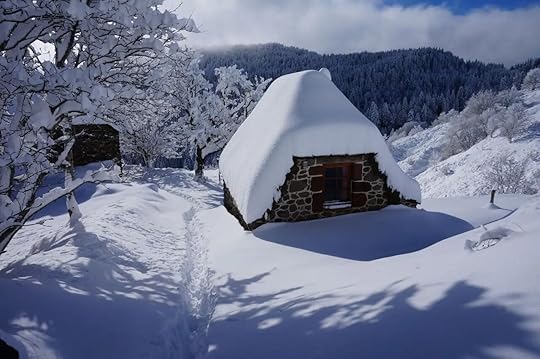 Photo: Airbnb
Photo: Airbnb Photo: Airbnb
Photo: Airbnb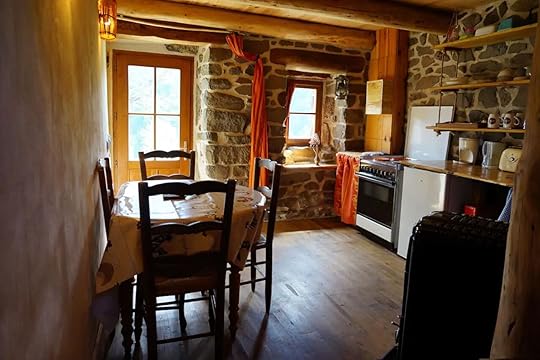 Photo: Airbnb
Photo: Airbnb Photo: Airbnb
Photo: AirbnbSee more photosThis storybook Airbnb in the French Alps clings to the southern slope of Mont Mézenc. Sitting at an altitude of 4,429 feet, the air is fresh and the mountain landscapes are astounding from all angles. The host provides copious firewood to ensure you stay warm and dry as the snow falls thick and heavy. Stockpile the cheese and wine; if you’re lucky, you might get snowed in for the season.
Three guests, one bedroom
Price: $64 per night
 Photo: Airbnb
Photo: Airbnb Photo: Airbnb
Photo: Airbnb Photo: Airbnb
Photo: Airbnb Photo: Airbnb
Photo: AirbnbSee more photosThis brand-new vacation apartment gives you a mix of downhill and cross-country pistes, tobogganing, sledding, and snowshoeing. The modern interiors have a subtle alpine theme and come with all the amenities you’d possibly need for a winter getaway in the mountains. There’s even a starter supply of spices and oils plus the option to purchase premium wines from the cooler.
Three guests, one bedroom
Price: $162 per night
 Photo: Airbnb
Photo: Airbnb Photo: Airbnb
Photo: Airbnb Photo: Airbnb
Photo: Airbnb Photo: Airbnb
Photo: AirbnbSee more photosThis Airbnb in the Austrian Alps is a short drive from the Bödele, Mellau, and Damüls ski centers. It’s an “upside down” design with the bathrooms on the first floor and the living quarters and kitchens on the second floor to capitalize on the scenery. Picture windows have awesome views over the valleys with an assortment of seating where you can wind down between activities.
Eight guests, three bedrooms
Price: $287 per night
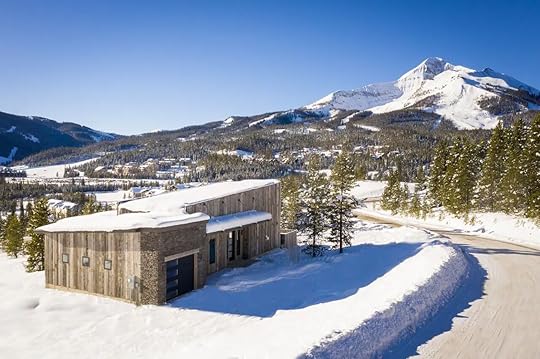 Photo: Airbnb
Photo: Airbnb Photo: Airbnb
Photo: Airbnb Photo: Airbnb
Photo: Airbnb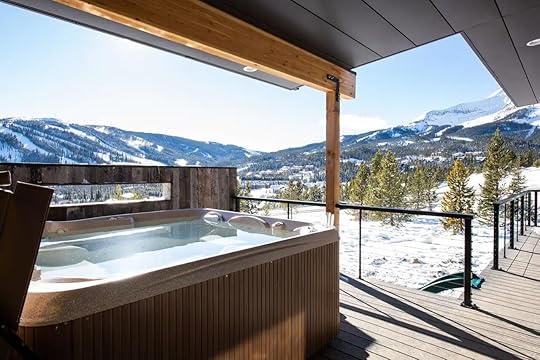 Photo: Airbnb
Photo: AirbnbSee more photosThis custom-built chalet near Big Sky Resort has ski-out privileges and mountain views galore. It sits on its own lot on the outskirts of town with a private hot tub and a ping pong table for everyone’s après needs. The interiors are top-notch, complete with a chef’s kitchen and a breakfast bar angled at Lone Peak. Elevate your stay by renting the host’s snow buggy.
Eight guests, three bedrooms
Price: $599 per night
 Photo: Airbnb
Photo: Airbnb Photo: Airbnb
Photo: Airbnb Photo: Airbnb
Photo: Airbnb Photo: Airbnb
Photo: AirbnbSee more photosThis designer chalet on the Swiss-French border floats above the teeny mountain hamlet of Biolley. It’s 10 minutes from the pistes of Champex-Lac where you can sign up for hiking with St. Bernard dogs and only 20-30 minutes from the La Fouly and Verbier ski resorts. Spare yourself the hassle of cooking and ask about having a locally sourced breakfast delivered to the terrace.
Four guests, two bedrooms
Price: $188 per night
 Photo: Airbnb
Photo: Airbnb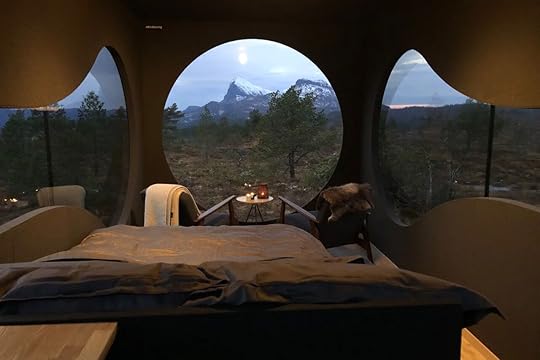 Photo: Airbnb
Photo: Airbnb Photo: Airbnb
Photo: Airbnb Photo: Airbnb
Photo: AirbnbSee more photosRoost amid the purest Norwegian nature at this unique Airbnb near Langeland Ski Center. The rental includes the main cabin where you’ll wake up to vistas of Lillehesten and Storehesten mountains plus a loo with a view. It’s a 15-minute hike up to Birdbox but that’s counteracted by the downhill ski-out. The friendly hosts will provide tapas and breakfast upon request to reduce the load.
Two guests, one bedroom
Price: $324 per night
 Photo: Airbnb
Photo: Airbnb Photo: Airbnb
Photo: Airbnb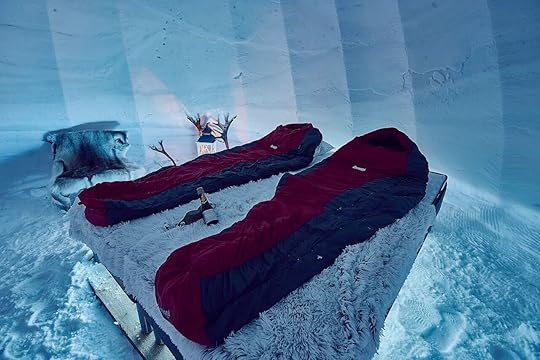 Photo: Airbnb
Photo: Airbnb Photo: Airbnb
Photo: AirbnbSee more photosFreeze the day and book this ice dome in Lapland before it melts. The hosts build these igloos every winter on their family-owned ranch where you might catch a sighting of the Northern Lights dancing overhead. They also offer an array of activities including snow surfing and snowshoeing. It’s minus degrees inside but your trusty long johns and the thermal bedding will keep you feeling toasty from head to toe.
Four guests, one bedroom
Price: $159 per night
20 Things To Know About Tourism in Saudi and How To Plan Your Trip

Once upon a time, you could only visit Saudi on a pilgrimage or a business sponsorship visa. But a few years ago, the country opened its doors to tourists from more than 60 countries, including the United States, by offering an eVisa. The eVisa is part of Saudi Vision 2030, the country’s plan to diversify its economy and emerge as a hub for tourism and entertainment — and there’s never been a better time to visit. With a blend of indulgent luxury and authentic charm, Saudi is rich in cultural experiences, breathtaking landscapes, extravagant accommodations, and futuristic visions.
Here’s everything you need to know to plan your trip and see this rapidly evolving destination for yourself.
How to get an eVisa
Photo: spc3mky/Shutterstock
1. Requirements and eligibility: Travelers from 63 countries, including the US, are eligible for the eVisa. American citizens also have the option of obtaining a visa on arrival or a transit visa. To apply for an eVisa, you need a passport with a minimum six-month validity, the address of family or friends that you’ll be staying with or a hotel booking, and a passport-size photo.
2. How to apply for the eVisa: To apply online, visit the eVisa portal, fill out an application, attach your passport photograph, and pay the fee. It takes approximately two to five business days for visa processing.
3. How much does it cost? The eVisa costs $130 and includes travel insurance.
4. Validity and entry-exit requirements: The tourist visa is valid for one year and allows for multiple entry and exits during that year. Tourists can spend a total of up to 90 days in the country.
What to pack (and what NOT to pack)
Photo: The Road Provides/Shutterstock
5. Clothing: Be sure to pack modest wear. It’s advisable for both men and women to wear attire that falls below the knees and covers the shoulders. Women should carry a hair cover if planning to visit mosques or other areas of religious significance.
6. Dress for the weather: If you’re visiting during the winter (October through March), bring a lightweight jacket or sweater. If traveling during the summer months, light-colored clothing and a cap will do you well.
7. Medicines: Any medications you’re bringing into the country should be accompanied by the prescription or a doctor’s note.
8. Prohibited: Recreational drugs and alcohol are prohibited in the country.
Getting around
Photo: Saudi Tourism Authority
9. Transportation: Uber and Careem (a popular ridesharing app in the region) are affordable and convenient ways to get around. You can also hail a licensed and metered taxi (they’re green) outside most airports, train and bus stations, and major shopping areas. Intercity buses are economical and run frequently.
To rent a car, you’ll need is a valid international driver’s license, your passport and visa documents, a payment method, and a contact number.
10. Currency and payments: The country’s currency is the Saudi Arabian Riyal (SAR), and at the time of writing $1 US is equivalent to around SAR 3.75. Most establishments accept major debit and credit cards and contactless payment methods like Apple or Google Pay. ATM machines are also widely available.
11. Cellular services: STC, Zain, and Mobily are the major mobile network operators and provide good phone and 4G or 5G internet connectivity in most parts of the country. You can purchase a prepaid SIM card for about $20 at kiosks in the airport or shopping malls. To purchase a SIM, you’ll need your passport and visa and to be prepared to have your fingerprints taken.
12. Language: English is widely spoken in Saudi. However, a few basic Arabic words — As-Salaam Alaykum (may peace be upon you), Marhaba (welcome), and Shukran (thanks) — will get you far. In smaller cities, Google Translate is your best friend!
Cultural customs and etiquette
Photo: Saudi Tourism Authority
13. Cultural customs: Hospitality is an important component of Saudi culture. It’s common to be invited for a cup (or several!) of coffee, even if you’re meeting the person for the first time. As with any culture, partaking in their company with an open mind and heart will help you establish friendships that last long after your trip is over.
14. Etiquette: It’s considered offensive to eat or drink with your left hand.
15. Photography: As with any place you visit, don’t photograph people without their permission.
What’s coming up
Photo: Saudi Tourism Authority
16. Riyadh Season: For nearly five months, the city of Riyadh is transformed into one large winter party. The season sees various events held at different locations (or zones) across the city. The 2023-24 Riyadh Season promises to be bigger than usual, with 11 zones and lots of concerts, shows, theme parks, and games.
17. MDL Beast Soundstorm, Riyadh: One of the most anticipated music festivals in the region, the MDL Beast Soundstorm promises the best of indie, EDM, house, disco, and more. Past performances have included the likes of David Guetta, Steve Aoki, and Armin Van Buuren. Dates are December 14-16, 2023, and tickets start from $45.
18. Red Sea Film Festival, Jeddah: Hosted at the historic site of Al Balad, the Red Sea Film Festival sees the who’s who of Saudi and Hollywood film industries in attendance. The third edition of the festival, running from Nov 30 to Dec 9, 2023, will feature screenings, workshops, celebrity talks, and red-carpet events. The Film Buff’s Bundle starts at $130.
19. 2023 FIFA Club World Cup, Jeddah: For the first time ever, Saudi will play host to the championships in December, 2023. The 20th edition of this club tournament is set to take place across two stadiums in Jeddah, and tickets run from $10 to $30. Soccer is a regional favorite, and with a few local clubs playing, you can be sure the energy in the stadiums will be infectious.
20. AlUla Moments: Set against the backdrop of centuries-old archeological wonders, events in AlUla are truly magical. The 2023-24 AlUla Moments has a lineup of events ranging from yoga retreats to astronomy classes, from archeological expeditions to a music and arts festival. It’s a perfect excuse to plan a trip. 
November 27, 2023
Volvo Will Give You a Premium, Expenses-Paid Trip To Sweden When Buy a Car

There’s no place quite like Sweden, whether you travel there for Stockholm or all of the gorgeous places outside of Stockholm). It can, however, be pricey. For those in the market for a new car, you can get that plus a free trip to Sweden when you purchase a Volvo. The car brand has a new buying option called the Overseas Delivery Tourist Program, where you can visit Sweden as a perk of buying one of the vehicles. All you have to do is buy a car and pick it up in Gothenburg.
It’s hard to imagine a more perfect perk to buying a vehicle. To take advantage of it, all that’s needed is to visit your local Volvo dealership to design your custom car or pick out a vehicle. The models that are available for this program are:
XC60XC60 RechargeXC90XC90 RechargeXC40 (excluding XC40 Recharge fully electric)V60 RechargeV60 Cross CountryV90 Cross CountryOnce you have chosen your vehicle, you put down a deposit and pick up your car at the Volvo factory in Gothenburg. Volvo will fly you and another guest there with premium airfare, priority booking, and other flight perks. Volvo will also cover the cost of your hotel accommodations for two nights and dinner and when you arrive in Sweden. Volvo will pick you and your guest up, drive you to your hotel, and give you a ride to the Volvo Factory Delivery Center, where you will have lunch, tour the Volvo factory and visit the Volvo Museum and pick up your brand new car.
From there, you can enjoy Sweden and drive around in your car for 14 days. When it’s time to go back to the States, you will drop your vehicle at an authorized drop-off point or the Volvo Factory Delivery Center, and Volvo will ship it back home for free. 
This Beautiful Abandoned House Is a Massachusetts Icon, and It’s in Danger of Being Demolished

Most summer days, an artist stands on the side of the road between the pavement and the marsh, painting the dilapidated Pink House at sunset. By every architectural metric, the Pink House is ugly. Balancing on the marsh that flanks the mile-long road from Newburyport to Plum Island in Massachusetts, the abandoned house survives, just barely, like a man in the twilight of life. The pink paint peels like dead skin, windows with no panes are a toothless smile, and the cordgrass creeps onto the porch threatening to reclaim the land in the name of nature.
According to local legend, it was built as a monument to spite. As part of a couple’s divorce agreement in the 1920s, the wife required the husband to build an exact replica of their family home for her to live in, but she didn’t specify where. He chose the salt marsh, which made it rather inhospitable. Despite the location, it’s said that the ex-husband’s family used it as a summer home until the 1940s, when it was sold and occupied by a series of families.

Photo: Anthony DeSantis
While its real history is lost to time, the house has been abandoned since the early 2000s, seeming to float on the marsh, peeling and crumbling and groaning with no company except the artists standing on the roadsides. To them, and to many who grew up passing it on their way to the beach, the Pink House isn’t an eyesore at all – it’s exquisite. Part of that beauty is its resilience, not only against time and nature, but against the human forces threatening to demolish it.
On the brink of destructionIn 2011, the U.S. Fish & Wildlife Service (USFWS) purchased the house along with nine acres of sensitive tidal creek and salt marsh habitat. According to Matt Hillman, refuge manager at the Parker River National Wildlife Refuge, the house was intended to serve as seasonal staff housing, but when asbestos and lead paint were discovered, the house’s restoration and habitability were considered economically and operationally infeasible.
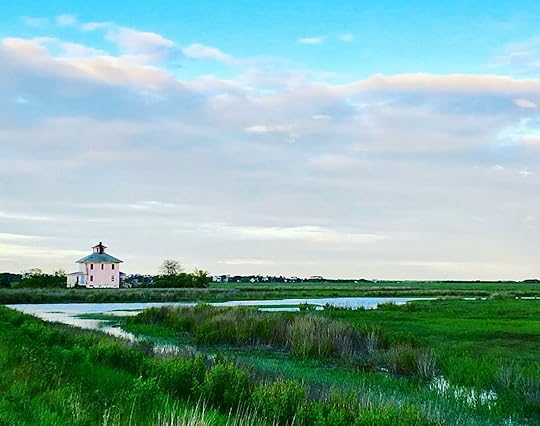
Photo: Kelly Page
While many believe caring for the Pink House falls under the USFWS’s responsibility, and aligns with their preservation interests, Hillman says the opposite is actually true. Their official mission is as follows:
To administer a national network of lands and waters for the conservation, management and, where appropriate, restoration of the fish, wildlife and plant resources and their habitats within the United States for the benefit of present and future generations of Americans.
“The long-term care and maintenance of a house located within otherwise intact salt marsh and upland habitat detracts from that mission,” Hillman tells me. “It pulls our limited resources (staff time and funds) away from accomplishing important work to protect threatened and endangered species, restore salt marsh habitat, provide high-quality public programming, and maintain aging critical infrastructure.”
There is one solution that seems simple: Sell the house to a local nonprofit or someone who can devote resources to taking care of it. Well, it’s not that easy. According to Hillman, “federal law stipulates that when lands are protected as part of the national wildlife refuge system, they are meant to be preserved in perpetuity. In this case, because the lands on which the house sits are of high ecological value to the refuge’s mission, only an equal value land exchange is applicable.”
The USFWS insists there are only two solutions: the Pink House must either be torn down, or exchanged for a land parcel of similar value and ecological significance, which contains a salt marsh or upland habitats. They’ve spent the past eight years seeking such a parcel, to no avail.

Photo: Leslie Scott-Lysan
And that’s how we got here. In October 2023, the USFWS proposed tearing down the Pink House and building a wildlife viewing platform in its place. They also opened a 30-day comment period for local residents to voice their opinions on the proposal, and the clock counting down the Pink House’s demise officially started ticking.
Tilting at pink windmillsThe threat of demolition seemed to jog people from a happy daydream. It became clear that the Pink House wasn’t rendered on canvas in permanent paint. It could be erased. Roused from this daydream, residents responded to the open comment period with sentimental pleas and valiant calls to arms. Photographers shared their Pink House photos online. Artists’ oil and watercolor depictions now hang in every coffee shop. Every day, it seems, editorials in defense of the Pink House crop up in the local paper.
One group that certainly hasn’t been sleeping on this ever-present threat is the Support the Pink House (STPH) organization. Founded in 2015, the nonprofit is dedicated to finding ways to stave off demolition and preserve the beloved local landmark. According to Kelly Page, who’s on the STPH Board of Directors, the group’s Instagram followers increased by 12 percent in November alone (since the comment period opened), account engagement increased 294 percent, and accounts reached increased by 525 percent. This engagement, she believes, has been driven by the now-urgent interest in saving the house.
“I’m also a photographer,” Page says, “and know firsthand how popular Pink House artwork is both locally and even throughout the region. The Pink House isn’t just a cultural icon, but an economic influence.”
Indeed, Pink House photos regularly prove among the most popular for local photographer Peter Neverette.
“My most popular photos are those of the Pink House,” he says. “Out of towners want something that symbolizes Newburyport, and nothing visually represents the area like the Pink House. Locals buy Pink House photos for similar reasons – because it holds a special place in their lives, or in their childhood memories.”

Photo: Peter Neverette
Unfortunately, no amount of Instagram followers, paintings sold, or nostalgia, matter to the federal government. Which leaves the question, now what?
Anyone in the market for a pink house?All kinds of questions could be raised right now.
Why can’t the USFWS just accept donations to repair it?
Why can’t nonprofits like STPH simply care for the house with volunteer support?
Why isn’t the Pink House’s historic status enough to save it?
And perhaps most significantly: Why did the USFWS purchase the house in the first place without doing their due diligence on its condition? Surely, as the voluntary stewards of a culturally significant property, they must also assume responsibility for its preservation.
All of these questions, particularly the last one, are valid but ultimately irrelevant. Only one question matters: Will a land exchange happen?
View this post on InstagramA post shared by Support to SAVE The Pink House (@supportthepinkhouse)
According to Hillman, here’s what it would take: “My sincere hope is that this 30-day public comment process sparks enough interest and publicity that a local landowner approaches the Service with a viable land exchange. Potentially suitable properties include those contiguous (preferred) or within one mile of refuge boundaries and containing salt marsh and/or adjacent upland habitats. Crucially, to comply with federal law, the exchange parcel must also be approximately equal in monetary value to the Pink House parcel, and of higher ecological value.”
The Pink House has been appraised at approximately $500,000. For context, salt marsh acreage usually runs about $1,000 per acre. So if you’ve got 400 acres of salt marsh lying around and you’re in the market for an old pink house, please contact the USFWS.
The fate of a cultural iconIt’s a story so old it’s become cliche: the beloved local landmark struggling to survive against government pragmatism. It’s easy to take sides in these stories. Rooting for the little guy and booing the evil government entity feels like a no brainer. But the story is always more complex than that.
The USFWS must understand that the Pink House is more than an inconvenient hindrance to its mission statement. Indeed, tearing it down would actually damage the organization’s relationship with the local community, complicating its long term mission. Similarly, Pink House supporters must contend with reality. A government entity won’t be moved by mere emotion. There are legitimate upkeep costs and roadblocks associated with the house that only concrete solutions, not picket signs, can solve.

Photo: Kelly Page
If the house is saved, it won’t be through petitions and impassioned pleas. It’ll be thanks to the same creativity the Pink House has been inspiring for a century. It’ll be because someone comes forward with a land parcel exchange, or because devoted residents came up with a constructive, workable alternative.
If the house is demolished, people will have to come to terms with the harsh reality that daydreams don’t last forever. Inspiring sights are often inspiring because they’re fleeting. A house adored for clinging to life against all odds may finally meet a long-expected death. Maybe that’s the Pink House’s story.
More like thisEpic StaysThis Hidden Hotel Is the Quintessential New England Beach GetawayMatador Network's Blog
- Matador Network's profile
- 6 followers



